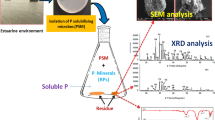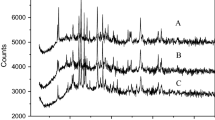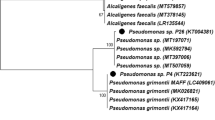Abstract
This study evaluates the efficiency of Phosphate solubilizing bacteria isolated from Effluent Treatment Plant sludge of Paradeep Phosphate Limited, Odisha, India, to solubilize rock phosphate (RP) and the mechanism and structural changes during solubilization investigated by scanning electron microscopy (SEM), X-ray diffraction (XRD), and Fourier-transform infrared spectroscopy (FTIR). Out of 13 bacterial isolates, Bacillus cereus S0B4, Solibacillus isronensis S0B8, and Bacillus amyloliquefaciens S0B17 strains were found to be the best RP solubilizers. This is the first report on S. isronensis S0B8 with the ability to solubilize RP. In particular, the potent strain B. cereus S0B4 showed maximum soluble P (338.5 mg/L) on the 7th day. Negative correlations (r = -0.70; p ≤ 0.01) were observed between soluble P concentration and pH, whereas positive correlation exists with the growth of B. cereus S0B4 (r = 0.91, p ≤ 0.01), S. isronensis S0B8 (r = 0.75, p ≤ 0.01), and B. amyloliquefaciens S0B17 (r = 0.77, p ≤ 0.01) respectively. The P release kinetics followed the 1st order model well (R2 = 0.8001–0.8503). It seems that H+ ions and organic anions released from the organic acids are major factors responsible for RP solubilization. The SEM observations demonstrate that B. cereus S0B4 corroded the RP surface significantly due to the proton attack. The XRD analysis confirms that the intensity of all mineral peaks decreases after treatment with B. cereus S0B4. The FTIR analysis indicated a significant decrease of calcite and fluorapatite’s vibrational bands with the disappearance of quartz.
Graphical abstract






Similar content being viewed by others
Change history
17 December 2022
A Correction to this paper has been published: https://doi.org/10.1007/s12223-022-01024-w
References
Aliyat FZ, Maldani M, El Guilli M, Nassiri L, Ibijbijen J (2020) Isolation and characterization of phosphate solubilizing bacteria from phosphate solid sludge of the Moroccan phosphate mines. Open Agric J 14
Alori ET, Glick BR, Babalola OO (2017) Microbial phosphorus solubilization and its potential for use in sustainable agriculture. Front Microbiol 8:971. https://doi.org/10.3389/fmicb.2017.00971
Bardiya MC, Gaur AC (1974) Isolation and screening of microorganisms dissolving low-grade rock phosphate. Folia Microbiol 19:386–389
Bhattacharjya S, Adhikari T, Kundu S, Sahu A, Patra AK (2019) Evaluation of microbial solubilisation of nano rock phosphate. Int J Curr Microbiol App Sci 8:1055–1069
Böttcher ME, Gehlken PL, Steele DF (1997) Characterization of inorganic and biogenic magnesian calcites by Fourier transform infrared spectroscopy. Solid State Ion 101–103:1379–1385. https://doi.org/10.1016/s0167-2738(97)00235-x
Chen YP, Rekha PD, Arun AB, Shen FT, Lai WA, Young CC (2006) Phosphate solubilizing bacteria from subtropical soil and their tricalcium phosphate solubilizing abilities. Appl Soil Ecol 34:33–41. https://doi.org/10.1016/j.apsoil.2005.12.002
Congeevaram S, Dhanarani S, Park J, Dexilin M, Thamaraiselvi K (2007) Biosorption of chromium and nickel by heavy metal resistant fungal and bacterial isolates. J Hazard Mater 146:270–277
Coutinho FP, Felix WP, Yano-melo AM (2012) Solubilization of phosphates in vitro by Aspergillus spp. and Penicillium spp. Ecol Eng 42:85–89
de Medeiros EV, Silva AO, Duda GP, dos Santos UJ, de Souza Junior AJ (2019) The combination of Arachis pintoi green manure and natural phosphate improves maize growth, soil microbial community structure and enzymatic activities. Plant Soil 435:175–185
de Oliveira MG, de Freitas ALM, Pereira OL, da Silva IR, Vassilev NB, Costa MD (2014) Mechanisms of phosphate solubilization by fungal isolates when exposed to different P sources. Ann Microbiol 64:239–249
de Oliveira Mendes G, Murta HM, Valadares RV, da Silveira WB, da Silva IR, Costa MD (2020) Oxalic acid is more efficient than sulfuric acid for rock phosphate solubilization. Miner Eng 155:106458
Delvasto P, Valverde A, Ballester A, Igual JM, Muñoz JA, González F, Blázquez ML, García C (2006) Characterization of brushite as a re-crystallization product formed during bacterial solubilization of hydroxyapatite in batch cultures. Soil Biol Biochem 38:2645–2654. https://doi.org/10.1016/j.soilbio.2006.03.020
Dorozhkin SV (2002) A review on the dissolution models of calcium apatites. Prog Cryst Growth Charact Mater 44:45–61. https://doi.org/10.1016/S0960-8974(02)00004-9
Gaind S (2017) Exploitation of orange peel for fungal solubilization of rock phosphate by solid state fermentation. Waste Biomass Valorization 8:1351–1360
Hamdali H, Moursalou K, Tchangbedji G, Ouhdouch Y, Hafidi M (2012) Isolation and characterization of rock phosphate solubilizing actinobacteria from a Togolese phosphate mine. Afr J Biotechnol 11:312–320
Hameeda B, Harini G, Rupela OP, Wani SP, Reddy G (2008) Growth promotion of maize by phosphate-solubilizing bacteria isolated from composts and macrofauna. Microbiol 163:234–242
Holt JG, Krieg NR, Sneath PHA, Staloj JT, Williams ST (1994) Bergey’s manual of determinative bacteriology-, 9th edn. Williams and Wilkins, Baltimore/London
Illmer P, Schinner F (1995) Solubilization of inorganic calcium phosphates-solubilization mechanisms. Soil Biol Biochem 27:257–263
Klaic R, Plotegher F, Ribeiro C, Zangirolami TC, Farinas CS (2017) A novel combined mechanical-biological approach to improve rock phosphate solubilization. Int J Miner 161:50–58
Kumari A, Kapoor KK, Kundu BS, Mehta RK (2008) Identification of organic acids produced during rice straw decomposition and their role in rock phosphate solubilization. Plant Soil Environ 54:72–77. https://doi.org/10.17221/2783-pse
Li L, Chen R, Zuo Z, Lv Z, Yang Z, Mao W, Liu Y, Zhou Y, Huang J, Song Z (2020) Evaluation and improvement of phosphate solubilization by an isolated bacterium Pantoea agglomerans ZB. World J Microbiol Biotechnol 36:27. https://doi.org/10.1007/s11274-019-2744-4
Li L, Lv Z, Zuo Z, Yang Z, Yuan X (2016) Effect of energy source and leaching method on bio-leaching of rock phosphates by Acidithiobacillus ferrooxidans. Hydrometallurgy 164:238–247. https://doi.org/10.1016/j.hydromet.2016.06.018
Mendes GO, Galvez A, Vassileva M, Vassilev N (2017) Fermentation liquid containing microbially solubilized P significantly improved plant growth and P uptake in both soil and soilless experiments. Appl Soil Ecol 117–118:208–211. https://doi.org/10.1016/j.apsoil.2017.05.008
Mendoza-Arroyo GE, Chan-Bacab MJ, Aguila-Ramírez RN, Ortega-Morales BO, Canché Solís RE, Chab-Ruiz AO, Cob-Rivera KI, Dzib-Castillo B, Tun-Che RE, Camacho-Chab JC (2020) Inorganic phosphate solubilization by a novel isolated bacterial strain Enterobacter sp. ITCB-09 and its application potential as biofertilizer. Agricu 10:383
Mhamdi R, Laguerre G, Aouani ME, Mars M, Amarger N (2002) Different species and symbiotic genotypes of field rhizobia can nodulate Phaseolus vulgaris in Tunisian soils. FEMS Microbiol 41:77–84
Nahas E (1996) Factors determining rock phosphate solubilization by microorganisms isolated from soil. World J Microbiol Biotechnol 12:567–572. https://doi.org/10.1007/BF00327716
Nobahar A, Sarikhani MR, Chalabianlou N (2017) Buffering capacity affects phosphorous solubilization assays in rhizobacteria. Rhizosphere 4:119–125
Paradeep Phosphates Limited (PPL) (2017-2018) Environment Statement report 18
Park JH, Bolan N, Megharaj M, Naidu R (2011) Isolation of phosphate solubilizing bacteria and their potential for lead immobilization in soil. J Hazard 185:829–836. https://doi.org/10.1016/j.jhazmat.2010.09.095
Paz A, Guadarrama D, López M, González JE, Brizuela N, Aragón J (2012) A comparative study of hydroxyapatite nanoparticles synthesized by different routes. Quim Nova 35:1724–1727. https://doi.org/10.1590/S0100-40422012000900004
Pikovskaya RI (1948) Mobilization of phosphorus in soil in connection with vital activity of some microbial species. Prikl 17:362–370
Prasad PSR, Chaitanya VK, Prasad KS, Rao DN (2005) Direct formation of the γ-CaSO4 phase in dehydration process of gypsum: In situ FTIR study. Am Mineral 90:672–678. https://doi.org/10.2138/am.2005.1742
Reddy MS, Kumar S, Babita K, Reddy MS (2002) Biosolubilization of poorly soluble rock phosphates by Aspergillus tubingensis and Aspergillus niger. Bioresour Technol 84:187–189. https://doi.org/10.1016/S0960-8524(02)00040-8
Qarni A, Billah M, Hussain K, Shah SH, Ahmed W, Alam S, Sheikh AA, Jafri L, Munir A, Malik KM, Khan N (2021) Isolation and characterization of phosphate solubilizing microbes from rock phosphate mines and their potential effect for sustainable agriculture. Sustainability 13:2151
Reyes I, Valery A, Valduz Z (2007) Phosphate-solubilizing microorganisms isolated from rhizospheric and bulk soils of colonizer plants at an abandoned rock phosphate mine. In First international meeting on microbial phosphate solubilization. Springer, Dordrecht 69–75
Rinu K, Pandey A (2011) Slow and steady phosphate solubilization by a psychrotolerant strain of Paecilomyces hepiali (MTCC 9621). World J Microbiol Biotechnol 27:1055–1062
Saikia BJ, Parthasarathy G, Sarmah NC (2008) Fourier transform infrared spectroscopic estimation of crystallinity in SiO2 based rocks. Bull Mater Sci 31:775–779. https://doi.org/10.1007/s12034-008-0123-0
Sarikhani MR, Khoshru B, Oustan S (2016) Efficiency of some bacterial strains in potassium release from mica and phosphate solubilization under in-vitro conditions. Geomicrobiol 33:832–838
Seshadri S, Ignacimuthu S, Lakshminarasimhan C (2004) Effect of nitrogen and carbon sources on the inorganic phosphate solubilization by different Aspergillus niger strains. Chem Eng Commun 191:1043–1052
Sowmya S, Rekha PD, Yashodhara I, Karunakara N, Arun AB (2020) Uranium tolerant phosphate solubilizing bacteria isolated from Gogi, a proposed uranium mining site in South India. Appl Geochemistry 114:104523
Swain AK, Panda S (2016) Studies of Physico-chemical characteristics of surface water at the vicinity of Paradeep Phosphate Limited, Paradeep. Odisha Asian J Chem 9:25–28
Teng Z, Shao W, Zhang K, Huo Y, Li M (2019) Characterization of phosphate solubilizing bacteria isolated from heavy metal contaminated soils and their potential for lead immobilization. J Environ Manag 231:189–197
Tuovinen OH, Bhatti TM, Bigham JM, Hallberg KB, Garcia O, Lindstrom EB (1994) Oxidative dissolution of arsenopyrite by mesophilic and moderately thermophilic acidophiles. Appl Environ 60:3268–3274. https://doi.org/10.1128/aem.60.9.3268-3274.1994
Wei Y, Zhao Y, Shi M, Cao Z, Lu Q, Yang T, Fan Y, Wei Z (2018) Effect of organic acids production and bacterial community on the possible mechanism of phosphorus solubilization during composting with enriched phosphate-solubilizing bacteria inoculation. Bioresour Technol 247:190–199
Whitelaw MA (2000) Growth promotion of plants inoculated with phosphate solubilizing fungi. Adv Agron 69:99–151
Xiao C, Wu X, Liu T, Xu G, Chi R (2017a) Microbial community structure of activated sludge for biosolubilization of two different rock phosphates. Appl Biochem 182:742–754. https://doi.org/10.1007/s12010-016-2358-3
Xiao C, Tingting L, Guang X, Ruan C (2017b) Characteristics and mechanisms of biosolubilization of rock phosphate by Aspergillus japonicus. Braz Arch Biol Technol 60
Xiao C, Wu X, Zhu L, Yu T, Xu Z, Chi R (2019) Enhanced biosolubilization of mid-low grade phosphate rock by formation of microbial consortium biofilm from activated sludge. Physicochem Probl Miner 55
Yu LY, Huang HB, Wang XH, Li S, Feng NX, Zhao HM, Huang XP, Li YW, Li H, Cai QY, Mo CH (2019) Novel phosphate-solubilising bacteria isolated from sewage sludge and the mechanism of phosphate solubilization. Sci Total Environ 658:474–484
Yu X, Liu X, Zhu T (2014) Walnut growth and soil quality after inoculating soil containing rock phosphate with phosphate-solubilizing bacteria. Sci Asia 40:21–27
Acknowledgements
The author gratefully acknowledges Hindustan Zinc Limited, Udaipur, Rajasthan, India, for providing the rock phosphate and Paradeep Phosphate Limited, Odisha, for ETP Sludge for present experiments. AcSIR Ph.D. student, Ms. Rojali Maharana expresses thanks to the Department of Science and Technology, Government of India, for providing INSPIRE fellowship (DST/INSPIRE/03/2015/000438, IF160155), and Prof. S. Basu the Director CSIR-IMMT, Bhubaneswar, Odisha, India, for providing lab facilities to undertake the study.
Author information
Authors and Affiliations
Contributions
RM and NKD conceived and designed research that contributed to the acquisition of data and writing the first version of the manuscript. RM conducted the experiment. RM contributed analytical tools. RM and NKD analyzed data. RM wrote the manuscript and contributed to the acquisition of data. NKD contributed for drafting and revising the manuscript and coordinated the project.
Corresponding author
Ethics declarations
Ethics approval
This article does not contain any studies with human participants or animals performed by any of the authors.
Conflict of interest
The authors declare no competing interests.
Additional information
Publisher's Note
Springer Nature remains neutral with regard to jurisdictional claims in published maps and institutional affiliations.
Highlights
• Effective rock phosphate (RP) solubilization by Bacillus cereus S0B4, Solibacillus isronensis S0B8, and Bacillus amyloliquefaciens S0B17isolated from ETP Sludge of PPL, Odisha, India.
• First report of RP solubilization by S. isronensis S0B8.
• Organic acids produced by microorganisms were responsible for RP solubilization and morphological and mineralogical changes, confirmed by SEM, XRD, and FTIR respectively.
Supplementary Information
Below is the link to the electronic supplementary material.
Rights and permissions
Springer Nature or its licensor (e.g. a society or other partner) holds exclusive rights to this article under a publishing agreement with the author(s) or other rightsholder(s); author self-archiving of the accepted manuscript version of this article is solely governed by the terms of such publishing agreement and applicable law.
About this article
Cite this article
Maharana, R., Dhal, N.K. Solubilization of rock phosphate by phosphate solubilizing bacteria isolated from effluent treatment plant sludge of a fertilizer plant. Folia Microbiol 67, 605–615 (2022). https://doi.org/10.1007/s12223-022-00953-w
Received:
Accepted:
Published:
Issue Date:
DOI: https://doi.org/10.1007/s12223-022-00953-w




